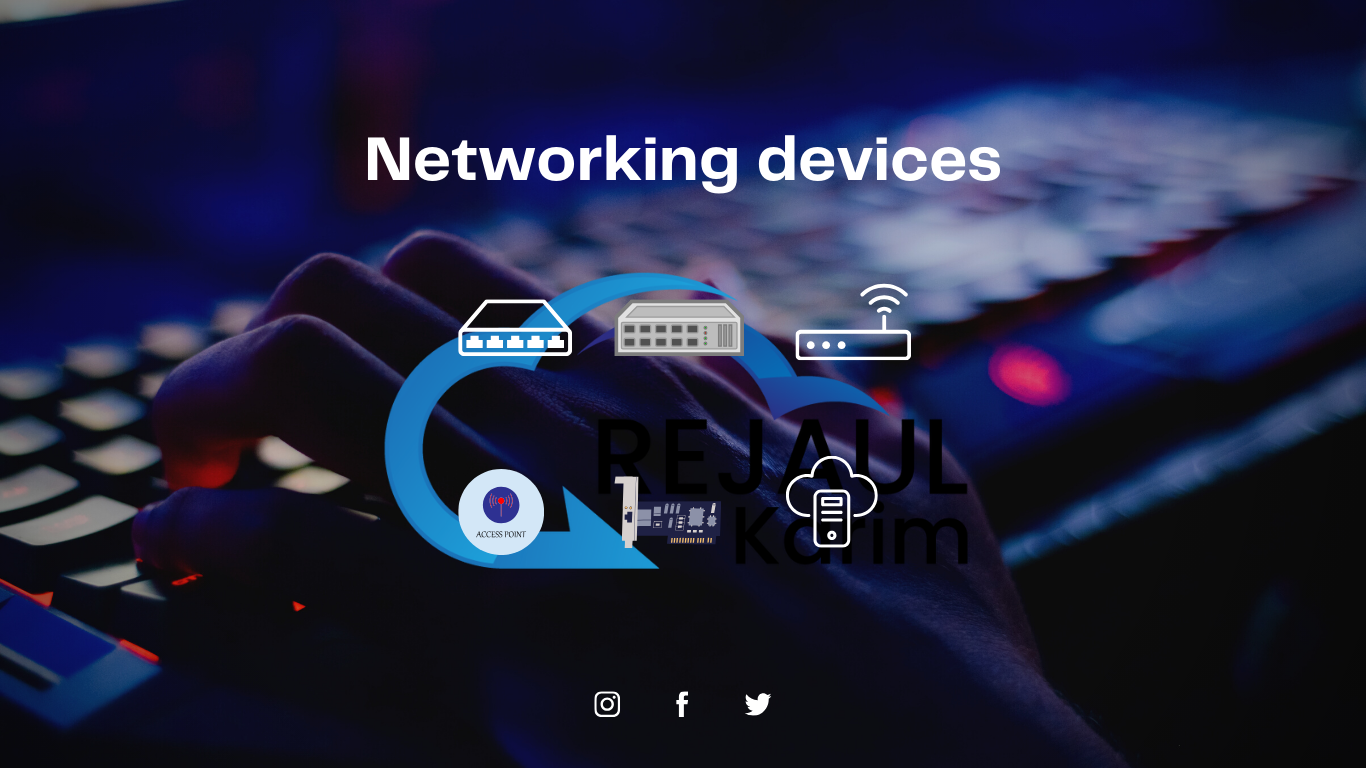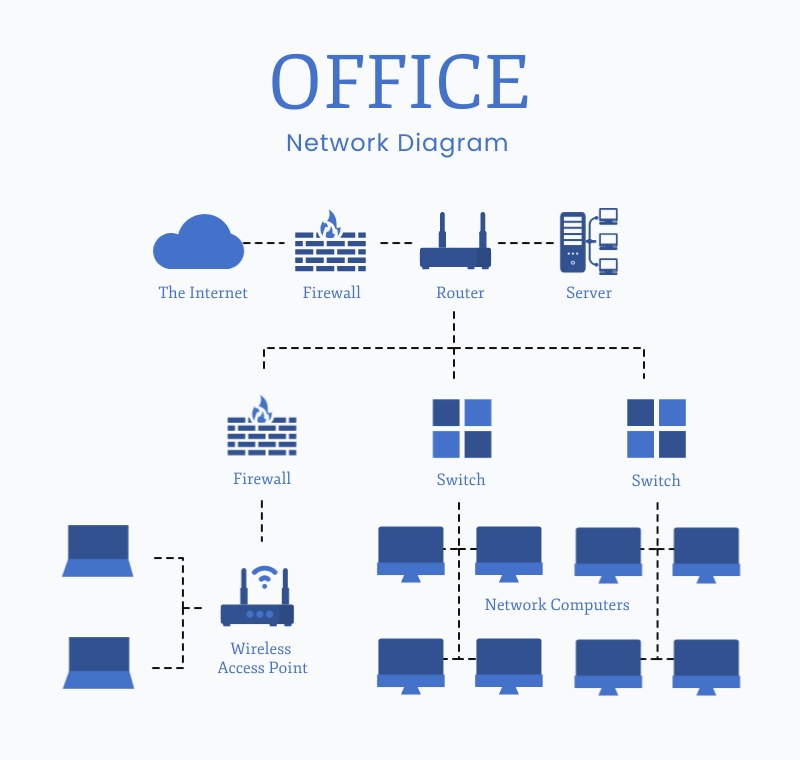Networking is a vast sea of opportunities that has routes to finally bag the dream jobs in accordance to each one’s line of interest. Networking has a varied range of devices working that initiate and facilitate efficient working in the field. There is a varied range of devices all aiming at making this possible in the realm of networking. Now let us see closely each of these devices how they work, and the purpose they serve, up close.
Top 11 Network Devices in Networking – Networking Hardwares
#1: Hub.

What do you understand by the word Hub in the world of computing?Hub (computing) refers to the connection point in a system which is the melting pot as data from many directions is converged here and further sent out in many varied directions. A hub also often acts as a switch by stopping certain data packets from reaching their destinations.
Types of Hubs:
- Active Hub.
- Intelligent Hub.
- Passive Hub.
CONFIGURATION:
- The runtime that has been set by the environment data hub needs to be shared on DASD in a SYSPLEX environment.
- To make a high availability hub that enables movement from one LPAR to another, whilst a recovery switchover. The hub host address needs to be defined by the means of Dynamic VIPA (DVIP).
Need of Hub In Networking:
- Multiple devices are connected by the means of a hub.
- It also qualifies as a repeater as it amplifies signals which have deteriorated after traveling over connecting cables.
- Hubs are the easiest in the entire family of network connecting a hub is the simplest in the family of network connecting devices because it connects LAN components with identical protocols.
#2: Switches

- Switches are devices that are operating a secondary data link layer in the OSI model. They establish connectivity in any network and by the means of a packet data is received and sent. Multiple computers are plugged into it as it has many ports.
Types of switches:
- KVM switch
- Managed switch
- Unmanaged switch
- Smart switch
- PoE Switch
CONFIGURATION
- The most number of small switches are employed by small businesses. They are also used at homes and office spaces. These require no configuration as they are plug and play.
- However, plug and play doesn’t always work. Small switches don’t offer any troubleshooting, logging, security, or manageability whatsoever.
Need For a Switch:
- Switches are key building blocks for any network. They connect multiple devices, such as computers, wireless access points, printers, and servers; on the same network within a building or campus. A switch enables connected devices to share information and talk to each other.
#3: Router.

- Router is defined as a networking device that sends data packets further between computer networks. They are able to perform traffic directing functions over the internet.
Types of Routers:
- Edge routers
- VPN routers.
- Wired routers
- Core routers
CONFIGURATION:
- The process to configure a router begins by unplugging or switching off the cable or DSL modem. Firstly, unplug or turn off the cable or DSL modem. Then the wireless router has to be plugged in and connected to the network cable into the port over the router that is labeled as ‘internet’ or’ WAN’. The other end is to be connected to the cable or DSL modem and the modem has to be started.
Need for a router:
- The router is one of the integral parts of a computing system.
- It works to manage traffic between networks by forwarding data packets to the IP address designated to them and also allowing multiple devices to use the same internet connection as well.
#4: Bridge.

- Let’s have a look at what qualifies as a bridge in the networking realm. Well, a bridge is another device that is used to connect LAN cable segments together. The bridge is operational at the data link layer of an OSI model. Bridges also facilitate packet filtering at the data link layer, which means that it can only pass the packets that are meant for the other side of the network.
CONFIGURATION:
- Bridging is one of the features that can be employed to establish a connection between 2 or more layer 2 interfaces together that too from the single broadcast domain.
- This then further forwards packets in software, basing it upon the layer 2 header. This resembles quite a lot to forward the logic to layer 2 switching. From where they get ahead into hardware.
Need for configuration:
There is a need for bridges as:
Bridges happen to connect two or more different LANs that have a similar protocol and further provide communication between the devices in them.
Bridges help in multiplying the network capacity of a single LAN by joining multiple LANs.
#5: Gateway.

A gateway can be defined as a network node that is employed in telecommunications that it tends to connect two networks which possess varying transmission protocols alongside. network as it’s important for all data to communicate with the gateway before it begins to get routed.
CONFIGURATION
To configure a Gateway the following steps are needed:
- Primarily install and configure the second network adapter.
- Install and configure the second network adapter, if you have not done so already. (See Installing a network adapter and Adapter management and configuration.)
- Choose an IP address for the second network interface, and then configure the network interface by following the instructions in Network interface management.
Need of a gateway:
A gateway is a network node that is used to connect two networks with varying transmission protocols together, in telecommunications.
#6: Modem

A modem is defined as a network device that both modulates and also demodulates analog carrier signals known as signals or sine waves, for encoding and decoding digital information for processing. Modems efficiently accomplish both tasks.
CONFIGURATION
Whilst using any device with a browser, you have to connect it to the WiFi network of that particular modem.
Open the browser and then enter the gateway address which is written at the back of that modem.
Now the final step is to enter the modem username and password, which should also be on the modem.
Need for a MODEM:
We need a modem to be able to send and receive data from two different networking routes; the internet provider’s connection and also one’s home network’s connection as well.
#7: Repeater.

A repeater is implemented in a system’s network to facilitate A repeater is implemented in computer networks to expand the coverage area of the network, repropagate a weak or broken signal and or service remote nodes. Repeaters amplify the received/input signal to a higher frequency domain so that it is reusable, scalable and available.
CONFIGURATION
- When in repeater mode, the access point tends to extend the range of any existing WiFi network.
- This mode is most preferred if a person is in a no Wifi zone or a place that has really poor reception.
#8: Access Point.

An access point is identified as a device that creates a wireless local area network, or WLAN, that often exists in an office or large building. An access point establishes a connection with a wired router, switch, or hub via an Ethernet cable, and projects a Wi-Fi signal to a designated area.
CONFIGURATION
- The access point has to be connected to one of the ports of one’s existing wired/wireless router and then the access point’s wireless settings have to be configured.
- Now web point’s web -based setup page is opened by entering the default IP address.
- On the web-based setup page, click on Wireless
- Enter the Network Name (SSID).
Need for an access point:
- Access points are useful for extending the wireless coverage of any existent network and further increasing the number of users that shall be connected to it.
Hopefully you were able to know the networking devices essential to perform and carry out daily and advanced computing as well. The devices are absolutely crucial for carrying out smooth working be it for individuals or organizations.
#9: WLC – Wireless LAN Controller

Cisco Wireless LAN Controller (WLAN), wireless controller, provides wireless performance of all mobile devices, offers limited hotspot coverage and more.
CONFIGURATION:
A wireless LAN controller (WLC) is a network component that is capable of managing wireless network access points and allows wireless devices to connect to the network.
It offers central control over network elements, simplifies individual component monitoring.
Need for WLC:
WLCs (Cisco WLC) are commonly used to have control over one’s routers, switches, firewalls, gateways etc. Monitoring Cisco WLC helps you determine the performance and efficiency of every device.
#10: NIC – Network Interface Card:

A network interface card (NIC) is a hardware component, typically a circuit board or chip, which is installed on a computer so it can connect to a network.
Configuration of NIC:
- To configure NIC firstly the control panel has to be opened. Then orderly, set View by to Category.
- Click Network and Internet.
- Click Network and Sharing Center.
- Select the local area network connection that is connected to the radio hardware and then select properties.
- If an unused network connection is available, the local area connection appears as an Unidentified network.
- If you plan to reuse your network connection, select the local area connection that you plan to use for the radio hardware.
- If you have only one network connection, check if you can connect wirelessly to the existing local area network. If you can, you can use the network connection for the radio hardware.
A pluggable USB is used as a Gigabit Ethernet LAN adapter instead of a NIC.
All options except Internet Protocol Version 4 (TCP/IPv4) are to be cleared. - Often it is observed that services like antiviral software, can cause intermittent connection problems with the radio hardware.
Need of NIC:
- A NIC is competent enough to provide computers with a dedicated , full- time connection from the network.
- It works to implement the physical layer circuitry which is hailed as essential for communicating with a data link layer standard. \
- Each card represents a device and can prepare, transmit and control the flow of data on the network.
#11: Load Balancer:
Load balancer is defined as the traffic cop, sitting in front of any server and routing client requests across all servers that are capable of fulfilling the former request.
It is done in a way that maximizes speed and capacity utilization and ensures that no server happens to be overburdened.

Configuration:
- A load balancer is configured with a protocol and a port for front-end (client to load balancer) connections and also a protocol and a port for back-end (load balancer to instance) connections.
Need for A load balancer:
- Load balancers let you evenly distribute network traffic to prevent failure that can be caused by overloading a particular resource.
- The employed strategy improves the performance and also the availability of applications, databases and other varied computing resources.
- It also aids processing user requests quickly and accurately.










